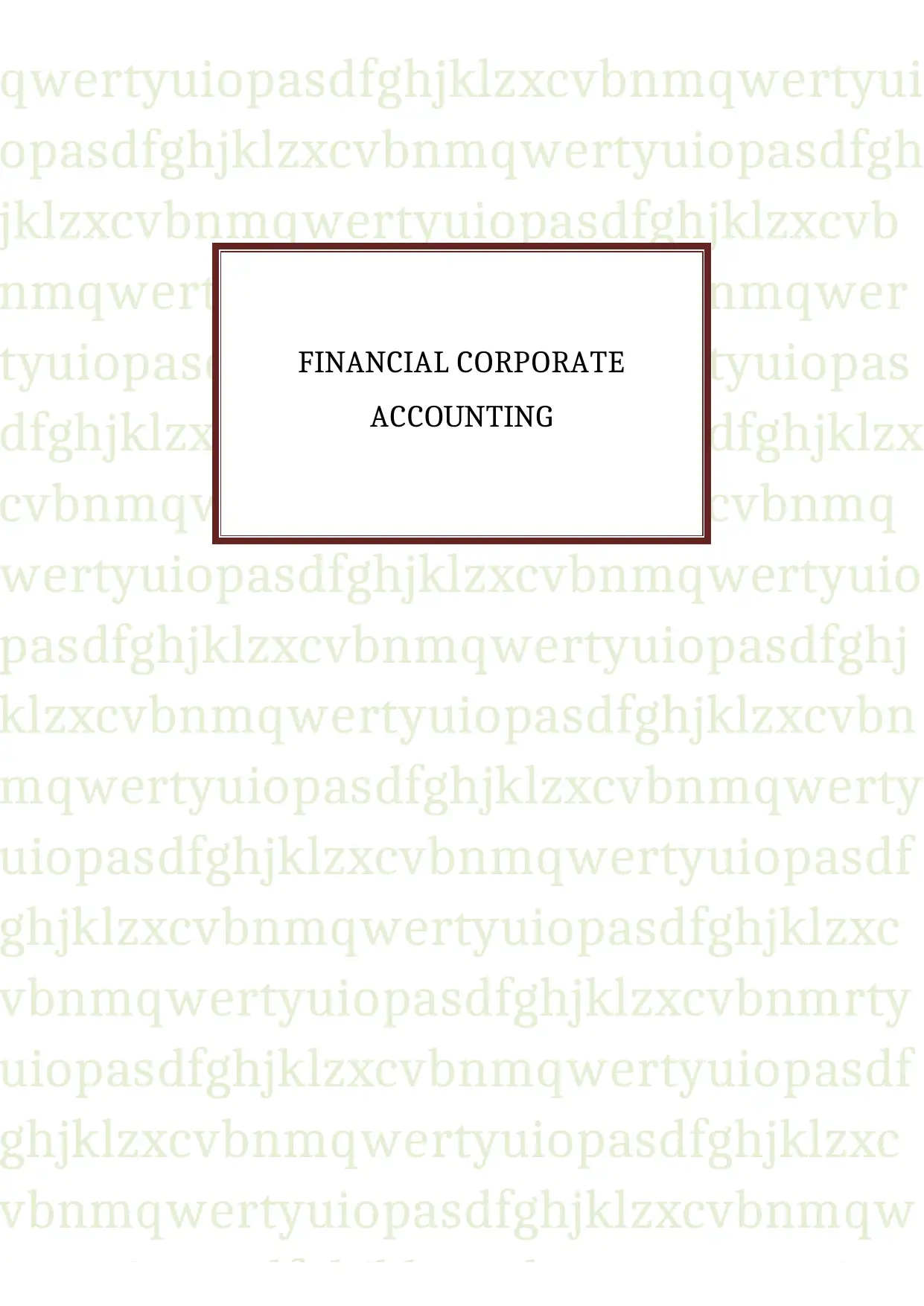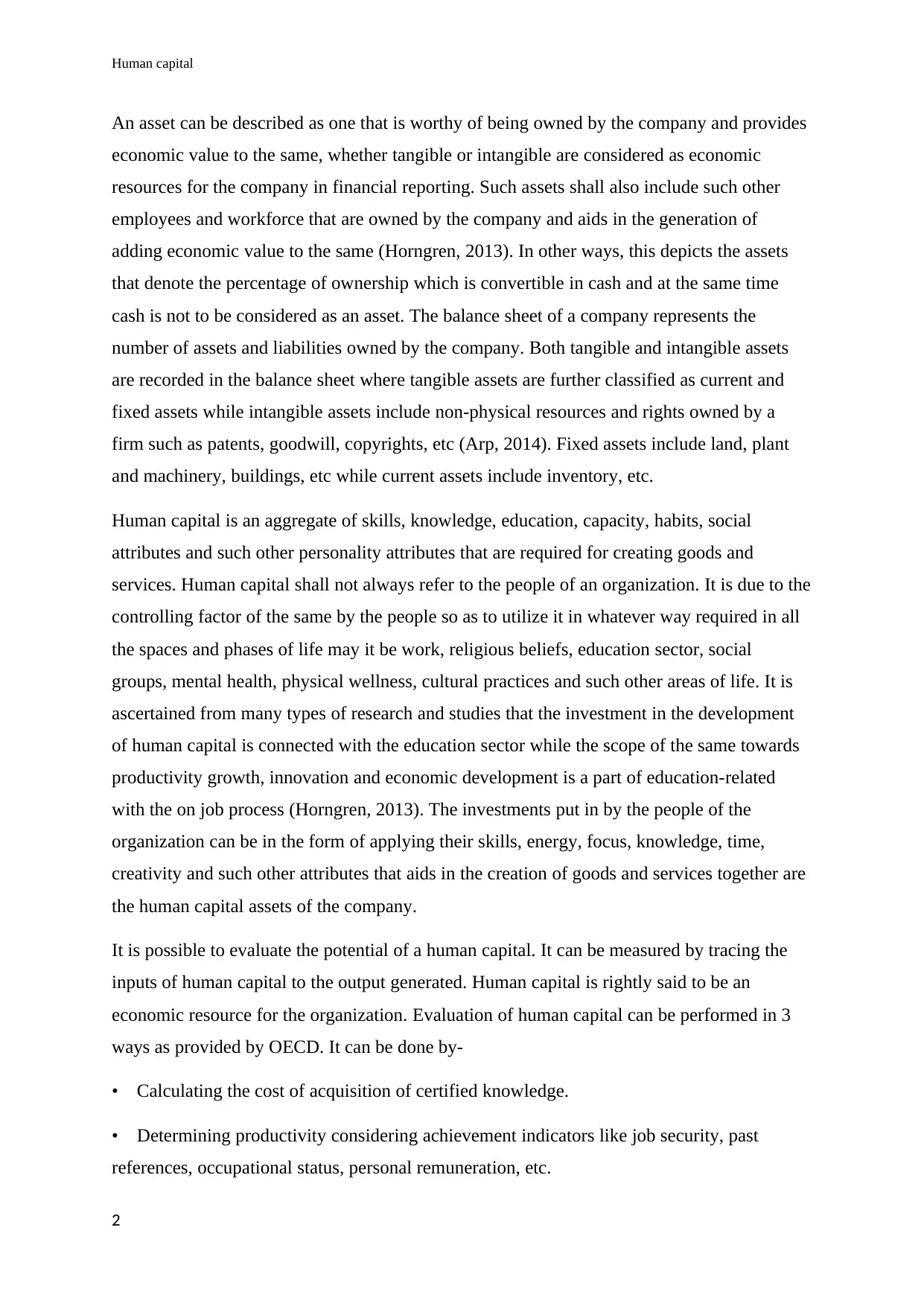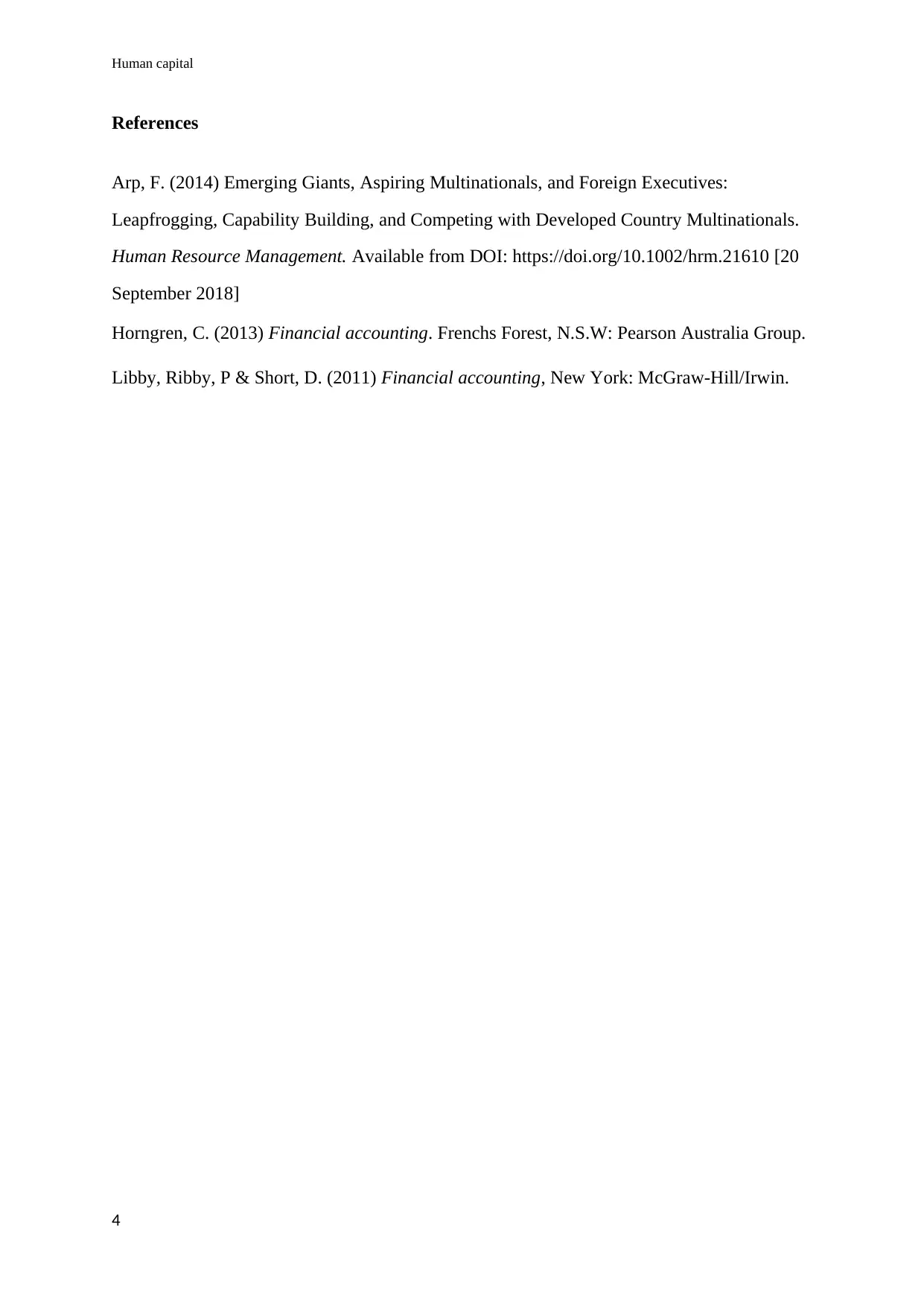BFA605 Semester 2 Case Study: Human Capital as a Financial Asset?
VerifiedAdded on 2023/06/04
|4
|983
|495
Case Study
AI Summary
This case study analyzes the recognition of human capital as an asset within the context of financial accounting. The assignment, part of BFA605, presents a scenario where the student, having previously written a letter to a journalist, is now asked to participate in a pre-recorded interview for a local television news program. The student is expected to explain their views on whether human capital should be recognized as an asset, considering the feedback received from other accountants after the initial article. The solution provided offers insights into the arguments for and against recognizing human capital as an asset, discussing the challenges of valuation and the implications for financial reporting. The study references key accounting concepts, asset classification, and the impact of human capital on an organization's financial statements, and provides an overview of OECD's approach to human capital evaluation.

qwertyuiopasdfghjklzxcvbnmqwertyui
opasdfghjklzxcvbnmqwertyuiopasdfgh
jklzxcvbnmqwertyuiopasdfghjklzxcvb
nmqwertyuiopasdfghjklzxcvbnmqwer
tyuiopasdfghjklzxcvbnmqwertyuiopas
dfghjklzxcvbnmqwertyuiopasdfghjklzx
cvbnmqwertyuiopasdfghjklzxcvbnmq
wertyuiopasdfghjklzxcvbnmqwertyuio
pasdfghjklzxcvbnmqwertyuiopasdfghj
klzxcvbnmqwertyuiopasdfghjklzxcvbn
mqwertyuiopasdfghjklzxcvbnmqwerty
uiopasdfghjklzxcvbnmqwertyuiopasdf
ghjklzxcvbnmqwertyuiopasdfghjklzxc
vbnmqwertyuiopasdfghjklzxcvbnmrty
uiopasdfghjklzxcvbnmqwertyuiopasdf
ghjklzxcvbnmqwertyuiopasdfghjklzxc
vbnmqwertyuiopasdfghjklzxcvbnmqw
ertyuiopasdfghjklzxcvbnmqwertyuiop
FINANCIAL CORPORATE
ACCOUNTING
opasdfghjklzxcvbnmqwertyuiopasdfgh
jklzxcvbnmqwertyuiopasdfghjklzxcvb
nmqwertyuiopasdfghjklzxcvbnmqwer
tyuiopasdfghjklzxcvbnmqwertyuiopas
dfghjklzxcvbnmqwertyuiopasdfghjklzx
cvbnmqwertyuiopasdfghjklzxcvbnmq
wertyuiopasdfghjklzxcvbnmqwertyuio
pasdfghjklzxcvbnmqwertyuiopasdfghj
klzxcvbnmqwertyuiopasdfghjklzxcvbn
mqwertyuiopasdfghjklzxcvbnmqwerty
uiopasdfghjklzxcvbnmqwertyuiopasdf
ghjklzxcvbnmqwertyuiopasdfghjklzxc
vbnmqwertyuiopasdfghjklzxcvbnmrty
uiopasdfghjklzxcvbnmqwertyuiopasdf
ghjklzxcvbnmqwertyuiopasdfghjklzxc
vbnmqwertyuiopasdfghjklzxcvbnmqw
ertyuiopasdfghjklzxcvbnmqwertyuiop
FINANCIAL CORPORATE
ACCOUNTING
Paraphrase This Document
Need a fresh take? Get an instant paraphrase of this document with our AI Paraphraser

Human capital
An asset can be described as one that is worthy of being owned by the company and provides
economic value to the same, whether tangible or intangible are considered as economic
resources for the company in financial reporting. Such assets shall also include such other
employees and workforce that are owned by the company and aids in the generation of
adding economic value to the same (Horngren, 2013). In other ways, this depicts the assets
that denote the percentage of ownership which is convertible in cash and at the same time
cash is not to be considered as an asset. The balance sheet of a company represents the
number of assets and liabilities owned by the company. Both tangible and intangible assets
are recorded in the balance sheet where tangible assets are further classified as current and
fixed assets while intangible assets include non-physical resources and rights owned by a
firm such as patents, goodwill, copyrights, etc (Arp, 2014). Fixed assets include land, plant
and machinery, buildings, etc while current assets include inventory, etc.
Human capital is an aggregate of skills, knowledge, education, capacity, habits, social
attributes and such other personality attributes that are required for creating goods and
services. Human capital shall not always refer to the people of an organization. It is due to the
controlling factor of the same by the people so as to utilize it in whatever way required in all
the spaces and phases of life may it be work, religious beliefs, education sector, social
groups, mental health, physical wellness, cultural practices and such other areas of life. It is
ascertained from many types of research and studies that the investment in the development
of human capital is connected with the education sector while the scope of the same towards
productivity growth, innovation and economic development is a part of education-related
with the on job process (Horngren, 2013). The investments put in by the people of the
organization can be in the form of applying their skills, energy, focus, knowledge, time,
creativity and such other attributes that aids in the creation of goods and services together are
the human capital assets of the company.
It is possible to evaluate the potential of a human capital. It can be measured by tracing the
inputs of human capital to the output generated. Human capital is rightly said to be an
economic resource for the organization. Evaluation of human capital can be performed in 3
ways as provided by OECD. It can be done by-
• Calculating the cost of acquisition of certified knowledge.
• Determining productivity considering achievement indicators like job security, past
references, occupational status, personal remuneration, etc.
2
An asset can be described as one that is worthy of being owned by the company and provides
economic value to the same, whether tangible or intangible are considered as economic
resources for the company in financial reporting. Such assets shall also include such other
employees and workforce that are owned by the company and aids in the generation of
adding economic value to the same (Horngren, 2013). In other ways, this depicts the assets
that denote the percentage of ownership which is convertible in cash and at the same time
cash is not to be considered as an asset. The balance sheet of a company represents the
number of assets and liabilities owned by the company. Both tangible and intangible assets
are recorded in the balance sheet where tangible assets are further classified as current and
fixed assets while intangible assets include non-physical resources and rights owned by a
firm such as patents, goodwill, copyrights, etc (Arp, 2014). Fixed assets include land, plant
and machinery, buildings, etc while current assets include inventory, etc.
Human capital is an aggregate of skills, knowledge, education, capacity, habits, social
attributes and such other personality attributes that are required for creating goods and
services. Human capital shall not always refer to the people of an organization. It is due to the
controlling factor of the same by the people so as to utilize it in whatever way required in all
the spaces and phases of life may it be work, religious beliefs, education sector, social
groups, mental health, physical wellness, cultural practices and such other areas of life. It is
ascertained from many types of research and studies that the investment in the development
of human capital is connected with the education sector while the scope of the same towards
productivity growth, innovation and economic development is a part of education-related
with the on job process (Horngren, 2013). The investments put in by the people of the
organization can be in the form of applying their skills, energy, focus, knowledge, time,
creativity and such other attributes that aids in the creation of goods and services together are
the human capital assets of the company.
It is possible to evaluate the potential of a human capital. It can be measured by tracing the
inputs of human capital to the output generated. Human capital is rightly said to be an
economic resource for the organization. Evaluation of human capital can be performed in 3
ways as provided by OECD. It can be done by-
• Calculating the cost of acquisition of certified knowledge.
• Determining productivity considering achievement indicators like job security, past
references, occupational status, personal remuneration, etc.
2

Human capital
• Examining people for competencies.
It was also stated that in the absence of generally accepted financial records, the transparency
of the cost and benefits of the human capital acquisition and its utilization shall become
concealed which will come in the way of users while making investment decisions
(Horngren, 2013). This is because of the evaluation of human capital has always remained a
debatable topic for it is impossible to measure the knowledge, skills and such other human
attributes owing to the incompatibility, non-physicality, immeasurability of the same.
Financial reporting allows the intended users, investors and the creditors of the company to
evaluate the true and fair view of the affairs of the company and its financial performance
along with an insight of the net cash inflows with respect to the timing, amounts and
uncertainty of the same.
There are no implications when it comes to sustainability perspective because human capital
is difficult to measure owing to its non-physical attribute. Though, human capital is an
important segment of any organization but owing to its non-physical attributes these are not
mentioned in the financial statements of the organizations. Not mentioning human capital in
the statements makes room for incomparability and allows the assets of a company to get
inflated. If there would have been any method so as to evaluate human capital the same
would have been reflected in the financials of the company (Libby, Ribby & Short, 2011).
Till the time, it is not possible to evaluate the human capital taken into use the accountants
shall not consider mentioning the same in the financials of the company.
From the overall analysis it came to the forefront that managing, evaluating and the recording
of human capital is significant for the organizations in the current market scenario. The
reporting of the same in the financials of the company is necessary but it would be a better
concept to have a separate statement for recording human capital assets so as to justify its
significance in the survival and growth of any organization ever since the evolution of
industries.
3
• Examining people for competencies.
It was also stated that in the absence of generally accepted financial records, the transparency
of the cost and benefits of the human capital acquisition and its utilization shall become
concealed which will come in the way of users while making investment decisions
(Horngren, 2013). This is because of the evaluation of human capital has always remained a
debatable topic for it is impossible to measure the knowledge, skills and such other human
attributes owing to the incompatibility, non-physicality, immeasurability of the same.
Financial reporting allows the intended users, investors and the creditors of the company to
evaluate the true and fair view of the affairs of the company and its financial performance
along with an insight of the net cash inflows with respect to the timing, amounts and
uncertainty of the same.
There are no implications when it comes to sustainability perspective because human capital
is difficult to measure owing to its non-physical attribute. Though, human capital is an
important segment of any organization but owing to its non-physical attributes these are not
mentioned in the financial statements of the organizations. Not mentioning human capital in
the statements makes room for incomparability and allows the assets of a company to get
inflated. If there would have been any method so as to evaluate human capital the same
would have been reflected in the financials of the company (Libby, Ribby & Short, 2011).
Till the time, it is not possible to evaluate the human capital taken into use the accountants
shall not consider mentioning the same in the financials of the company.
From the overall analysis it came to the forefront that managing, evaluating and the recording
of human capital is significant for the organizations in the current market scenario. The
reporting of the same in the financials of the company is necessary but it would be a better
concept to have a separate statement for recording human capital assets so as to justify its
significance in the survival and growth of any organization ever since the evolution of
industries.
3
⊘ This is a preview!⊘
Do you want full access?
Subscribe today to unlock all pages.

Trusted by 1+ million students worldwide

Human capital
References
Arp, F. (2014) Emerging Giants, Aspiring Multinationals, and Foreign Executives:
Leapfrogging, Capability Building, and Competing with Developed Country Multinationals.
Human Resource Management. Available from DOI: https://doi.org/10.1002/hrm.21610 [20
September 2018]
Horngren, C. (2013) Financial accounting. Frenchs Forest, N.S.W: Pearson Australia Group.
Libby, Ribby, P & Short, D. (2011) Financial accounting, New York: McGraw-Hill/Irwin.
4
References
Arp, F. (2014) Emerging Giants, Aspiring Multinationals, and Foreign Executives:
Leapfrogging, Capability Building, and Competing with Developed Country Multinationals.
Human Resource Management. Available from DOI: https://doi.org/10.1002/hrm.21610 [20
September 2018]
Horngren, C. (2013) Financial accounting. Frenchs Forest, N.S.W: Pearson Australia Group.
Libby, Ribby, P & Short, D. (2011) Financial accounting, New York: McGraw-Hill/Irwin.
4
1 out of 4
Related Documents
Your All-in-One AI-Powered Toolkit for Academic Success.
+13062052269
info@desklib.com
Available 24*7 on WhatsApp / Email
![[object Object]](/_next/static/media/star-bottom.7253800d.svg)
Unlock your academic potential
Copyright © 2020–2025 A2Z Services. All Rights Reserved. Developed and managed by ZUCOL.





